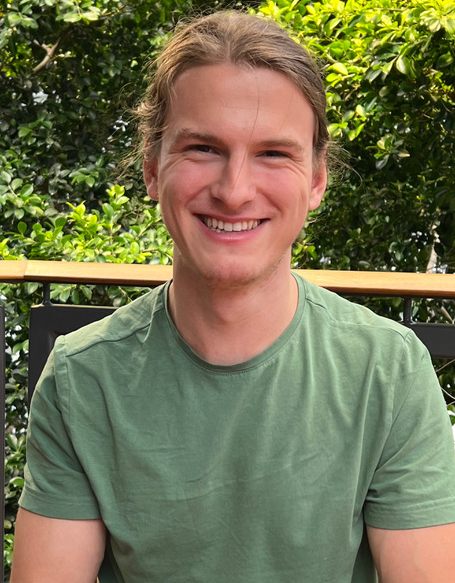“My professors at U-M helped me feel more at home” — finding your place as a transfer student

Computer science major Taras Palczynski first became interested in computer science 10 years ago in pursuit of making video games. He began his computing education at Washtenaw Community College where he graduated with an associates degree in 2020 and then transferred to the University of Michigan. Recently, he has been exploring the design of infrastructure for audio software engineers to implement microtonal and xenharmonic music technologies into their tools.
He recently presented his Honors Thesis, “Meshing Parametric Surfaces to Follow Lines of Curvature,” which provides a method to mesh a parametric surface where the edges of the polygonal mesh follow the surface’s lines of curvature, in addition to algorithms for constructing lines of curvature and a novel method for finding features in the principle direction vector field.
We sat down with Taras to learn more about being a transfer student and studying CSE at U-M. Here’s what he had to say:
What first got you interested in computer science?
Ten years ago, I wanted to make my own video games, but I didn’t know how to code. I researched game engines and found Unity. There weren’t many tutorials back then, so I learned how to code by reverse engineering other people’s example code in forum posts. I’d copy and paste different elements into my code, be met with compile errors, and then research those errors to understand why it wasn’t working. Eventually I began to understand the fundamentals of programming and started to build my own 3D games.
How has your experience been as a transfer student?
I transferred during the pandemic. U-M classes were all online, which was a significantly different learning medium from what I had prior. With in-person classes I used to be one on one with my teachers asking questions consistently throughout lectures and afterwards. My U-M professors and IAs during that time often prefaced class with giving the right-away for people to interrupt for questions. Their reassurance and encouragement allowed me to have a learning experience similar to my past in-person experiences. With this, I felt the pandemic had less of an impact on my learning at U-M. Once U-M returned to in-person a year later, all my professors continued to be really personable and show value in questions asked throughout lectures, which was amazing.
Why did you choose the Honors track in LSA for CS?
My experience with computer science even while taking U-M classes has been exploration-focused. Therefore pursuing an Honors thesis allowed me to explore topics related to computer science that U-M classes do not explore directly. I had multiple ideas for topics, which included computer science topics in microtonal music and geography. I eventually settled on the computer graphics topic of meshing parametric surfaces, which resonated with the origins of why I began my computer science career. My experience with my thesis advisor Prof. Sugih Jamin and my second reader Prof. Austin Yarger was an unforgettable, enriching, and broadening experience. I thank them very much for their advice and guidance.
How was your experience writing a thesis?
I’d been learning through research and exploration my whole computer science career, but I never had experience doing formal research. My experience writing a thesis began like my exploration-focused past, but quickly deviated as I never had to communicate my research through a paper before. Also, most of my time was spent ensuring any claims I made were verified by other research, or was supported by my own results. My advisor taught me to keep a journal which contained all of my possible citations even if I didn’t plan to use them. The entire process was very new to me, and when I do formal research again, I will be much more prepared.
Have there been any faculty or staff members you’ve found especially helpful in the transition?
As I transferred during the pandemic, at first I felt out of place, especially behind a screen. Thankfully, the professors and IA’s I had at U-M were very personable and took time out of their day to discuss topics unrelated to class which made me feel more connected with them. Their interest and time spent getting to know me really helped me feel more at home. Prof. Greg Bodwin was an especially kind professor in this way.
What are some of your activities outside of the classroom?
I love working on different projects unrelated to my daily work. Currently I’m working on audio and visual projects. One project is writing a library for making it easier for audio software engineers to introduce new musical tunings into their audio programs. Another project is designing and building custom circuitry for home lighting. In addition, last semester I started two new casual clubs at U-M to share my passion for music and embedded systems: Casual Music Makers Club and Control Your Game. I started Control Your Game with a friend who is an electrical engineering major at U-M. Both clubs introduced me to other people at U-M with similar interests in computer science, music, gaming, electrical engineering, and embedded systems.
 MENU
MENU 
